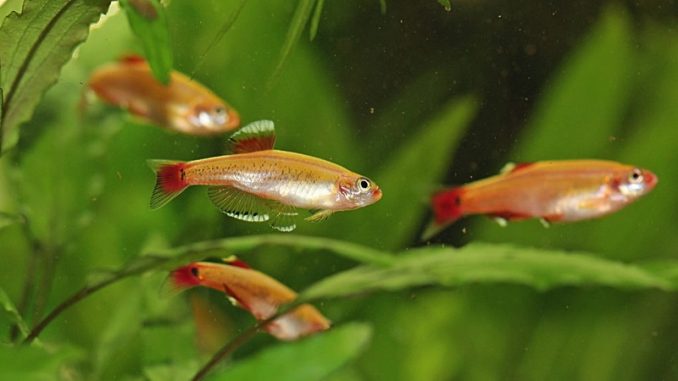
If you’re active in the fish hobby, you might associate Rosy Red Minnows with feeder fish. But these minnows also make great pets! They are fast swimmers and it’s fun to watch them whizzing through the water.
While they do best with optimal water conditions–something that I strongly advocate for all aquarium residents–their care is not complex. That is, it is not that they need little care; rather, it’s not complicated to provide them with excellent care. This ease of care makes them an excellent choice for beginning enthusiasts.
The other thing that is interesting about Rosy Red Minnows is that they can also be kept in ponds, so if you are an experienced hobbyist wanting to try something new, you could start a pond with Goldfish, Koi, and Rosy Reds.
Another consideration is that Rosy Red Minnows don’t require a large tank–a group of 5 or 6 can manage in a 10-gallon tank, so if you have been holding off on establishing an aquarium because of space constraints, Rosy Red Minnows may suit your needs.
In this article, I’ll discuss everything you need to know about raising Rosy Red Minnows as pets. I’ll discuss some background, breeding habits, food requirements, health concerns, and ideal habitat and water parameters.
TABLE OF CONTENTS
Rosy Red Minnows Facts & Overview
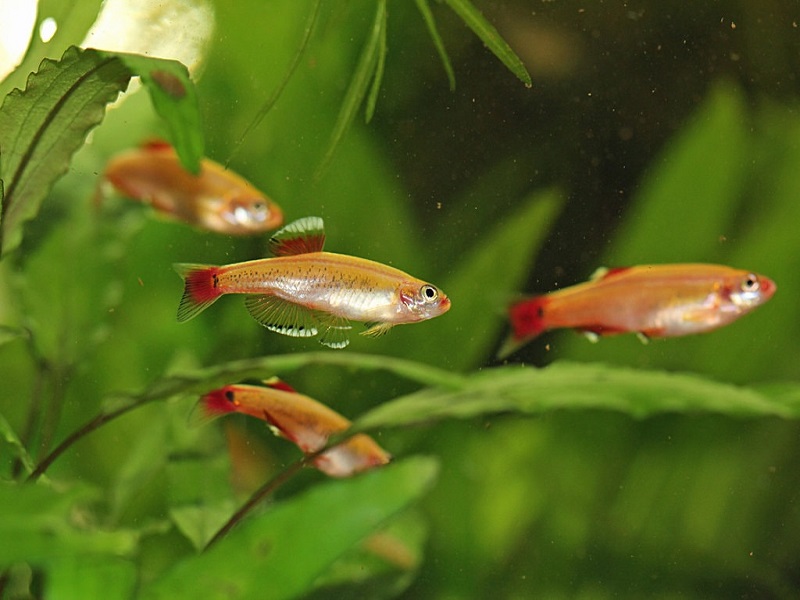
| Category | Rating |
| Care Level: | Easy |
| Temperament: | Peaceful |
| Color Form: | Orange, pink, golden |
| Lifespan: | 2-4 years |
| Size: | 2-3 inches |
| Diet: | Omnivore |
| Family: | Cyprinidae |
| Minimum Tank Size: | 10 gallons |
| Tank Set-Up: | Freshwater with caves and rocks |
| Compatibility: | Peaceful commnunity |
Rosy Red Minnows, a scientific name Pimephales promelas, are found throughout North America, from Canada to the United States to Mexico. They inhabit ponds, streams, lakes, and wetlands, and are one of the most resilient and versatile freshwater fish around. Although they have a fairly short lifespan of no more than 4 years, they are adaptable to many different conditions and can survive in a wide range of temperatures.
Also known as Bait Fish, Blackhead Minnows, Fathead Minnows, Feeder Fish, Rosys, and Tuffies, Rosy Red Minnows are not often thought of as pets. As you can guess from some of their other monikers, many aquarium stores sell them as live food for predatory fish.
Many in the fish hobby regard them first as feeder fish. While their ability to survive in myriad conditions does make them ideal feeder fish, it also makes them great pets.
Rosy Reds are peaceful fish that love to swim, and they make a great addition to a community tank. Because they don’t require sophisticated water parameters, they are also great beginner fish.
If you wanted to, you could keep a dedicated Rosy Red Minnow tank and a community tank; they breed so prolifically that you could keep some as pets and use some as feeder fish. Keepers of predatory fish often raise their own Rosy Red Minnows as feeder fish in order to ensure healthy and quality food for their fish.
Typical Behavior
In optimal conditions in captivity, you can expect your Rosy Red Minnows to live for approximately 2 to 4 years. Considering they don’t start breeding until they reach the age of two, that’s not a lot of time. Indeed, Rosy Red Minnows who breed will have a life expectancy on the lower end of that spectrum, as the breeding process is difficult on the Rosy Red Minnows.
The level of care also affects their lifespan. Although Rosy Red Minnows are resilient creatures, they will live longer when given proper care and optimal conditions. Things you can do to ensure that your Rosy Red Minnows thrive include:
- Regular water changes
- Consistent water parameters
- Friends: Rosy Red Minnows are much happier when they’re kept in groups
- Proper diet and nutrition
- Enough space for swimming
Appearance
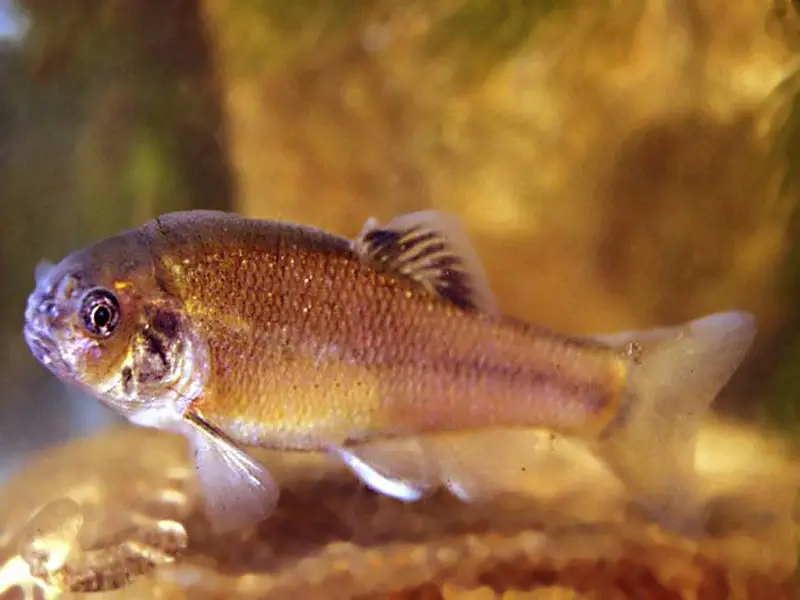
Although from their name you would think Rosy Red Minnows are red, in actuality they are usually golden, pale orange, or pink. They have a solid color, but the hue gets lighter at the upper part of the fish. They also have translucent fins.
The females have smaller bodies than the males, but both sexes have slender bodies, with round eyes that lay laterally on their flat heads. Their bodies actually resemble torpedos, a feature that allows them to swim very fast.
Distinguishing between males and females
One of the best ways to tell which Rosy Red Minnows are males and which are females is by looking at size. The males are about an inch longer than the females, measuring in at 2-3 inches (5-7.5 cm), while the females are 1-2 inches (2.5-5 cm) in length.
Other differences are the darker heads of the males, as well as the fatty tubercles that grow on the males as they ready themselves for breeding. Finally, white or gold bars on both the dorsal fins and back of the head are male Rosy Red Minnow identifiers.
The coloration of the females is also brighter, and their heads are smaller.
Habitat and Tank Conditions
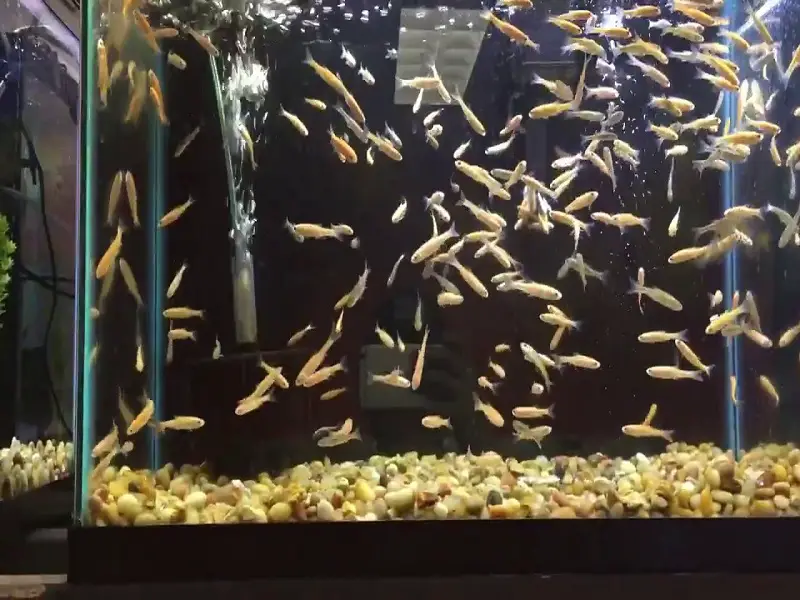
While Rosy Red Minnows are adaptable to many different conditions in their natural habitats of lakes, ponds, and rivers, you should keep a smaller range of temperatures in your home aquarium. One reason for this is to allow for continuous breeding (read more about breeding below.)
Rosy Red Minnows are resilient fish, but you don’t want to take that quality for granted. Starting with a tank size of at least 10 gallons, you should provide driftwood, rocks, and hiding places for your Rosy Red Minnows. They will also enjoy plants (floating and planted). Just make sure you leave your Rosy Red Minnows room to swim.
For substrate, my first choice for Rosy Red Minnows is gravel. However, if you need an alternative, soft sand would also work. I would choose the substrate based on the needs of your other aquarium residents. If you have a bottom feeder that needs a softer substrate, go with that since the Rosy Red Minnows are so adaptable.
Pro tip: If you are adding Rosy Red Minnows to an already established tank, don’t change the substrate to accommodate the Rosy Red Minnows. Uprooting plants and changing out the substrate can really mess up the biosphere of your aquarium and put all your fish, invertebrates, and plants at risk.
If you’re planning on breeding your Rosy Red Minnows, you’ll need to provide them with a cave for egg scattering. If you get an inexpensive clay pot, turn it sideways in the aquarium and bury the bottom part of it, your Rosy Red Minnows will be happy to claim it as territory.
Of course, if you’re housing multiples, you’ll need more than one pot so that the males don’t fight over it.
Pond Life
If you’re a more advanced aquarist who is looking to branch out from the traditional home aquarium, you might be interested in the option of keeping Rosy Reds in a pond, where they also thrive.
Maybe you’ve been thinking about a Koi pond, and want to experiment with a multi-species environment. Rosy Red Minnows will add coloration to the pond and, as you’ll read later on, they can share Koi food, as well as feasting on insects and larvae.
A pond habitat will not require a huge investment in time and care, so if you have space, you might consider raising some Rosy Red Minnows in a pond, where they will even survive the winter months.
Water Conditions
Clean water is key for Rosy Red Minnows, as it is for all fish. After that non-negotiable requirement, the other parameters are quite wide. Rosy Red Minnows are very forgiving with temperature, pH, and hardness, so even beginners can handle the parameters with ease.
Although I am listing optimal temperatures below, Rosy Red Minnows are still capable of surviving outside these parameters and are also able to tolerate varying levels of oxygen and water flow. It’s kind of amazing how seemingly indestructible they are, with reported survival in temperatures within the range of 32-100°F (0-37°C).
With regular water changes and a decent filter, you should be able to keep your Rosy Red Minnows happy and healthy. Just watch out for a filter with a really strong current and block the intake with a sponge to prevent the Rosy Red Minnow fry from getting sucked up in the filter.
The optimal parameters to ensure the best quality of life for Rosy Red Minnows:
- pH levels: 6-8
- Water hardness: mildly soft or very hard
- Water temperature: 70° to 80°F (21.1° to 26.7° C)
Although we have established the flexibility of Rosy Red Minnows, I feel it’s important to point out that although they are adaptable, you want to avoid sudden changes in conditions. While they can survive in freezing or tropical temperatures, you want to keep the range consistent. They won’t do well with a big or sudden jump in parameters.
What Size Aquarium Do They Need?
10 gallons is the minimum size tank you will need for a group of Rosy Red Minnows. It’s important to remember that the 10-gallon recommendation is for a dedicated tank, so if you are housing other species, you’ll need a larger tank.
How Many Can Be Kept Per Gallon?
You could keep 5 or 6 Rosy Red Minnows in a 10-gallon tank, although if you can go bigger, that would be better.
Tank Mates
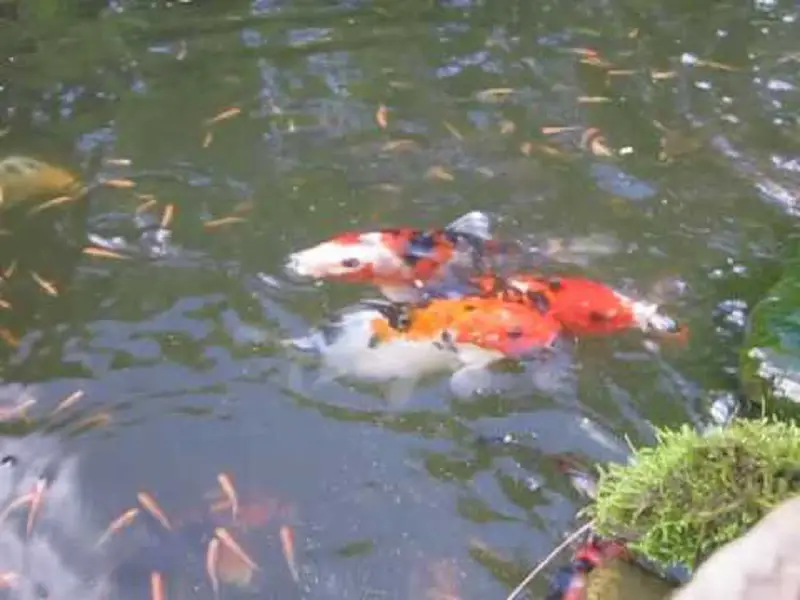
Proper tank mates for Rosy Red Minnows really depend on your purposes. If you are using them as feeder fish, you’re not really looking for a long-term tankmate and will be “housing” them with predators.
If your Rosy Reds are pets, you should choose peaceful tank mates that won’t see them as a meal. Stay away from any aggressive fish and stick to those that are smaller than they are.
Suitable Tankmates
- Amano Shrimp
- Bristlenose Pleco
- Cherry Shrimp
- Dojo Loach
- Ghost Shrimp
- Hillstream Loach
- Mystery Snail (not for ponds)
- Types Of Goldfish
Keeping Rosy Red Minnows Together
Rosy Red Minnows should be kept in groups–this allows for the company and allows the breeding process to commence. They are peaceful with each other, save for possible rows between males who are trying to mark their territory for breeding.
Diet
Rosy Red Minnows are not at all picky about what they eat; they’re omnivores that will eat a variety of things. They actually can be sort of tank cleaners if you keep them around long enough, and will consume algae, insect larvae, and planktons so that they don’t overtake your aquarium.
While what you feed them should be mainly flake or pellet food (they actually will eat Koi and Goldfish food if you are keeping those), they can be given treats of bloodworms, brine shrimp, daphnia, and tubifex.
You can also try spirulina food if they need more green matter. Blanched vegetables can also be offered, including
- Cucumber
- Zucchini
- Shelled peas
I recommend feeding Rosy Red Minnows twice a day, but only as much as they can consume in a few minutes. Discard any leftover vegetables to maintain water cleanliness.
Care
The best thing you can do to care for your Rosy Red Minnows and your other aquarium inhabitants is to make sure your Rosy Reds are healthy. This starts with quarantining any Red Rosy Minnows before adding them to your tank.
Although Rosy Red Minnows can survive even the most trying of water conditions, they have a tendency to carry parasites and other diseases, so in order to protect your aquarium and fish. I recommend a 4-week quarantine in a separate tank. While they are in quarantine, you should treat them for any parasites, bacteria, and fungus.
Remember that many people see Rosy Red Minnows as nothing more than feeder fish, so they may not be getting the care that aquarium stars get. But whether your intent is to have a pet or a feeder fish for your predatory friends, in my opinion, it is best to treat each fish with the highest care standards and provide them with optimal conditions.
Even if your goal is to use them as food, don’t you want your predatory fish to eat the best quality food? You wouldn’t want to feed them sickly, diseased food. And even if your pet Rosy Red Minnows could survive with substandard care, wouldn’t you want them to thrive?
You can see the difference in coloring and size in healthy Rosy Red Minnows. Rosy Reds that are well cared for are less stressed and therefore super peaceful. You’ll enjoy having them as part of your aquarium community, and because they can tolerate a variety of water conditions, they can mix with many types of freshwater fish and invertebrates.
Breeding
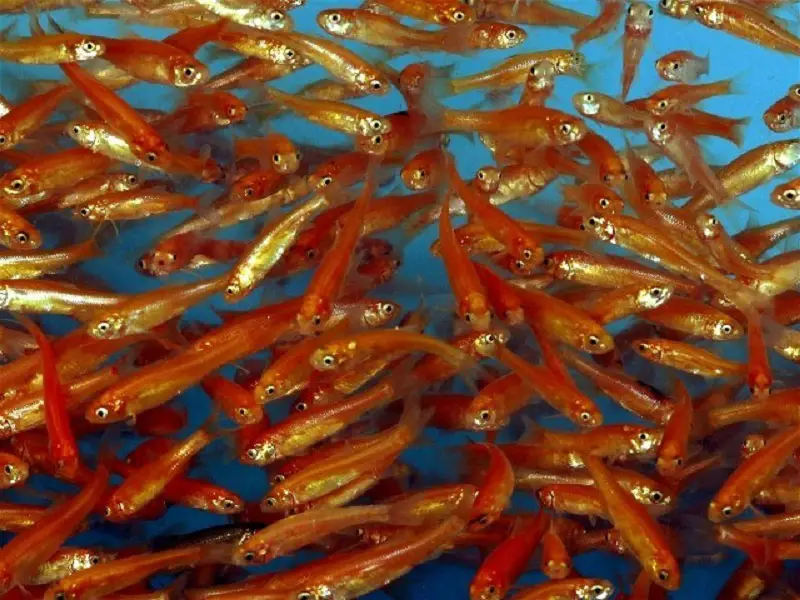
Rosy Red Minnows breed pretty constantly in captivity. In the wild, their fertile months are between May and September, when they can enjoy their ideal breeding water temperature between 50° – 78° F (10-25.6° C). In your home aquarium, however, you can control the temperature and encourage spawning year rounds.
Although Rosy Red Minnows mature at 6 months of age, they don’t breed until they are between 1 and 2 years old. With a lifespan of 2 to 4 years, that could leave a very short window of opportunity.
When they do spawn, females choose a log or other flat area and lay as many as 400 eggs at once; the males are in charge of babysitting the eggs, which hatch 4 or 5 days after fertilization. 2 or 3 days post-hatching, the fry becomes active, at which time they can handle baby brine shrimp and micro worms.
Fun Fact: Because they are so easy to breed, many enthusiasts raise Rosy Red Minnows as breeder fish for their predatory fish. By breeding their own feeder fish, aquarium hobbyists can rest easy knowing that their fish are getting healthy feeders.
You’ll know when the male Rosy Red Minnow is ready to breed because of the growth of fatty tissue and tubercles on the top of his head. This development is how they get their nickname Fathead Minnows. The male fish uses the tubercle to clean the top of a cave or other territory, to which he will lure a female Rosy Red Minnow.
Pro tip: There may be some competition among the males as they try to stake a claim on a particular love nest, but these fights are not usually bloody.
If and when he is successful in securing the female’s attention, the male and female will share a complex dance, after which she will deposit her eggs in the cave. Assuming ownership of the eggs, the male then banishes the female from the cave.
Unlike other species of minnows, Rosy Red Minnows don’t just scatter and run; they stay and guard their eggs; well, the males do, anyway. Part of protecting the eggs involves rubbing them with an antifungal contained in their head and nose. Male Red Rosy Minnows will stop at nothing to protect their eggs, even going after much larger fish to do so.
Once the fry hatch, however, the male loses interest and will ignore his young.
Are Rosy Red Minnows Suitable for your Aquarium?
Rosy Red Minnows are hardy and simple to care for. Versatile enough to keep in a home aquarium or a pond, these little fish are a great addition for any enthusiast. These freshwater minnows are great for beginners, breedable, and interesting enough to capture the attention of more experienced hobbyists.
Whether you’re looking for a pet or a feeder fish, Rosy Red Minnows fit the bill.
Do you keep Rosy Red Minnows as pets or use them as feeder fish? We’d love to know your experiences with these fish, so please share in the comments below.
FAQ
Is my Rosy Red Minnow a vegetarian?
Actually, Rosy Red Minnows are omnivores; they’ll eat just about whatever you offer them. But you’re right in a sense–their diet should be primarily plant-based. They’ll eat the algae that are growing in your tank, but otherwise, they can have vegetarian pellets or flakes. They can have Koi or Goldfish pellets, and they also like spirulina and blanched vegetable pieces.
Do I need to have a separate breeding tank?
Rosy Red Minnows do not require a separate breeding tank. They pretty much take care of business on their own as long as you provide them with the proper breeding water temperature of 50° – 78° F (10-25.6° C) and set up enough caves for the males to have their breeding nest. You’ll want to make sure that you cover the intake on the filter to keep the fry safe from strong currents that could pull them in.
You could use a separate tank if your community aquarium has inhabitants that might eat the fry.
I’m just starting my fish keeping hobby. Would these fish be a good choice?
I actually can’t think of a better fish to start with than Rosy Red Minnows. They are able to survive in varying water conditions, so as a beginner, you don’t have to worry too much about a very small window for temperature, pH, water hardness, and oxygen levels. As long as you keep the tank clean and stay consistent in your water levels, you’ll be able to maintain Rosy Red Minnows nicely.
They also take little effort to breed (see the above question), so you can experience new life in your aquarium early on in your hobby, which is another reason they are a great starter fish.
What is the average lifespan for Rosy Red Minnows?
Rosy Red Minnows have an average lifespan of 2-4 years in captivity.
I have limited space for my aquarium. Are Rosy Red Minnows an appropriate fish?
You can keep 5 or 6 Rosy Red Minnows in a 10-gallon tank, which qualifies as a nano tank, so unless you really need a tabletop micro tank, you should be able to keep Rosy Reds with no problem. I have heard of people who keep a small group of Rosy Red Minnows in a 5-gallon tank, but I would not recommend that–they need room to swim freely.

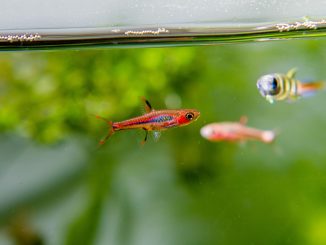
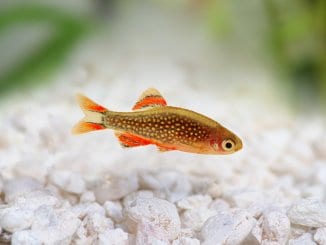
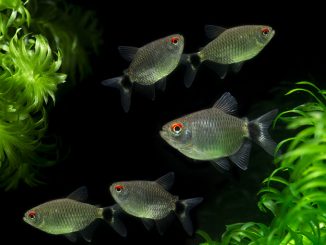
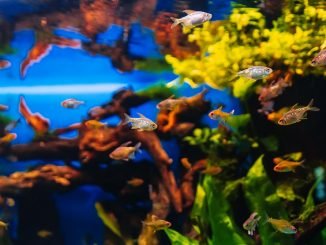
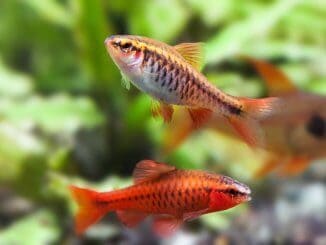
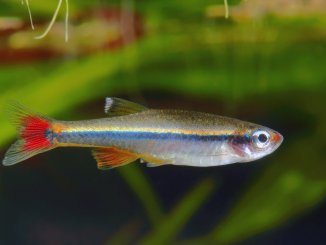
While an awesome fish finding healthy ones can be a problem. Being primarily sold as feeders, they are often overcrowded and little attention is spent on water quality. Like most new additions these may need to spend more time in a quarantine tank
Thank you for the information. Maybe I missed the following ; I hav e a substantial pond with Koi primarily. They over winter here in Wisconsin. Are these fish ready to spend a winter under ice with my Koi.
Given that you recommend a monthly quarantine, would these fish survive nonquaranteen pond life with Koi ?
I would be very interested in fish that can over-winter in Wisconsin.
I have 5 rosy red minnows with one black mor goldfish. They seem fine except I just noticed one of the rosies bottom dorsal fin was nipped. He is staying at the top of the water. He is eating but is not swimming very well, yet does move around the top of the tank a lot. Will this fin heal or will I lose him?
I have a 11000 gal pool to pond and I added approximately 30 rosy reds. Now I have 300 to 400 cute tiny babies all over. Will my goldfish or koi eat them. They seem to be staying where the strong current returns.
My goldfish ate the rosy reds. I added rosy reds 2 years in a row, and both times they disappeared in a matter of days. The pond is fairly large.